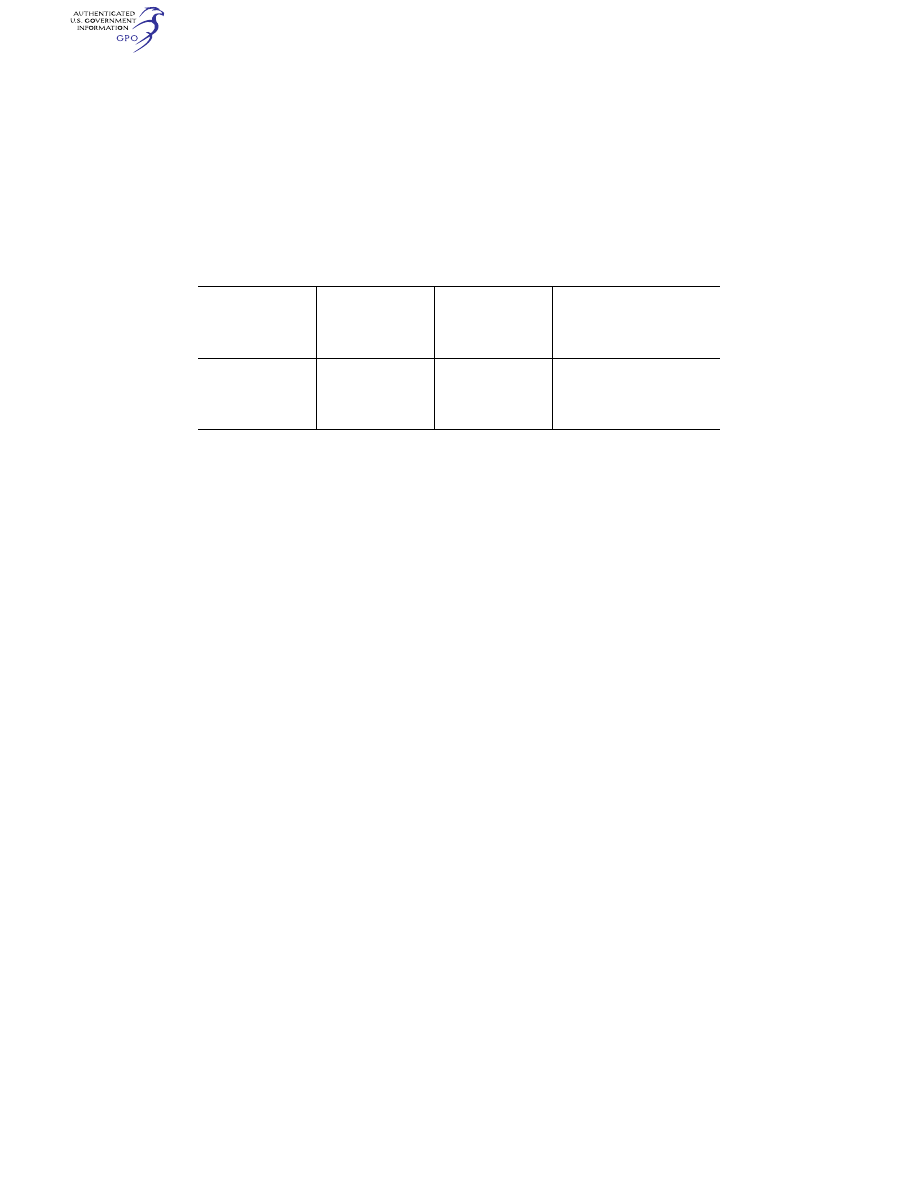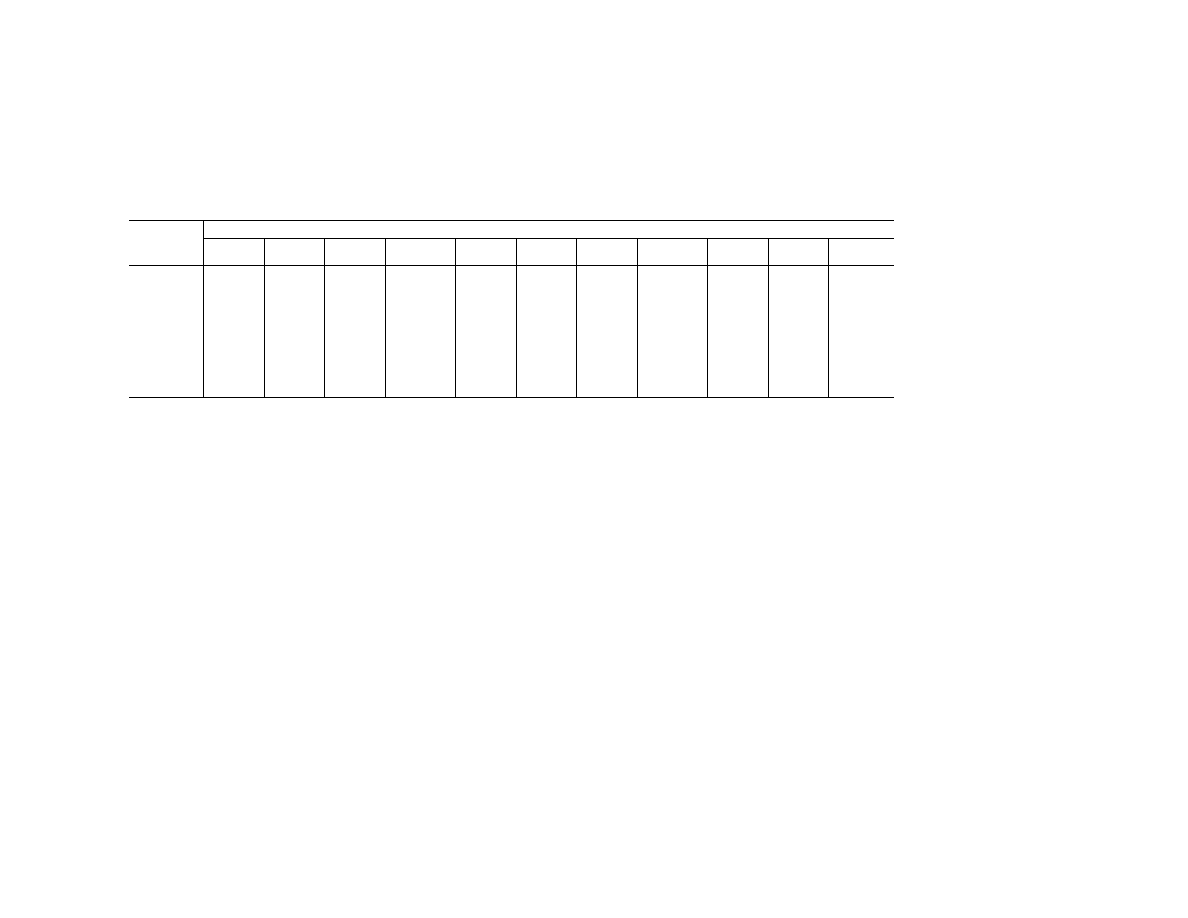
864
49 CFR Ch. I (10–1–23 Edition)
§ 175.78
Q
UANTITY AND
L
OADING
T
ABLE
—Continued
Applicability
Forbidden
Quantity Limitation: 25 kg
net weight of hazardous
material plus 75 kg net
weight of Division 2.2
(non-flammable com-
pressed gas) per cargo
compartment
No limit
Cargo-only aircraft— ..........
Packages not authorized
aboard a passenger-car-
rying aircraft and dis-
playing a Cargo Aircraft
Only label.
Inaccessible (Note 1) ........
Not applicable ...................
Accessible (Note 2).
Note 1 to § 175.75(f):
The following materials are not subject to this loading restriction—
a. Class 3, PG III (unless the substance is also labeled CORROSIVE).
b. Division 6.1 (unless the substance is also labeled for any hazard class or division except FLAMMABLE LIQUID).
c. Division 6.2.
d. Class 7 (unless the hazardous material meets the definition of another hazard class).
e. Class 9, Limited Quantity, or Excepted Quantity material.
f. Articles of Identification Numbers UN0012, UN0014, or UN0055 also meeting the requirements of § 173.63(b).
g. Articles of Identification Numbers UN3528 or UN3529.
Note 2 to § 175.75(f):
Aboard cargo-only aircraft, packages required to be loaded in a position that is considered to be accessible include those load-
ed in a Class C cargo compartment.
[76 FR 82178, Dec. 30, 2011, as amended at 78 FR 65486, Oct. 31, 2013; 81 FR 35544, June 2, 2016;
82 FR 15892, Mar. 30, 2017; 85 FR 83402, Dec. 21, 2020; 87 FR 44998, July 26, 2022]
§ 175.78
Stowage compatibility of
cargo.
(a) For stowage on an aircraft, in a
cargo facility, or in any other area at
an airport designated for the stowage
of hazardous materials, packages con-
taining hazardous materials which
might react dangerously with one an-
other may not be placed next to each
other or in a position that would allow
a dangerous interaction in the event of
leakage.
(b)(1) At a minimum, the segregation
instructions prescribed in the following
Segregation Table must be followed to
maintain acceptable segregation be-
tween packages containing hazardous
materials with different hazards. The
Segregation Table instructions apply
whether or not the class or division is
the primary or subsidiary risk.
(2) Packages and overpacks con-
taining articles of Identification Num-
bers UN3090 and UN3480 prepared in ac-
cordance with § 173.185(b)(3) and
(c)(4)(vi) must not be stowed on an air-
craft next to, in contact with, or in a
position that would allow interaction
with packages or overpacks containing
hazardous materials that bear a Class 1
(other than Division 1.4S), Division 2.1,
Class 3, Division 4.1, or Division 5.1
hazard label. To maintain acceptable
segregation between packages and
overpacks, the segregation require-
ments shown in the Segregation Table
must be followed. The segregation re-
quirements apply based on all hazard
labels applied to the package or over-
pack, irrespective of whether the haz-
ard is the primary or subsidiary haz-
ard.

865
Pipeline and Haz. Matls. Safety Admin., DOT
§
175.78
T
ABLE TO
P
ARAGRAPH
(b): S
EGREGATION
T
ABLE
Hazard label
Class or division
1
2.1
2.2, 2.3
3
4.1
4.2
4.3
5.1
5.2
8
9
see (b)(2)
1 ........................
Note 1 ........
Note 2 ........
Note 2 ........
Note 2 ............
Note 2 ........
Note 2 ........
Note 2 ........
Note 2 ............
Note 2 ........
Note 2 ........
Note 2
2.1 .....................
Note 2 ........
....................
....................
........................
....................
....................
....................
........................
....................
....................
X
2.2, 2.3 ..............
Note 2 ........
....................
....................
........................
....................
....................
....................
........................
....................
....................
3 ........................
Note 2 ........
....................
....................
........................
....................
....................
....................
X (Note 3) ......
....................
....................
X
4.1 .....................
Note 2 ........
....................
....................
........................
....................
....................
....................
........................
....................
....................
X
4.2 .....................
Note 2 ........
....................
....................
........................
....................
....................
....................
X ....................
....................
....................
4.3 .....................
Note 2 ........
....................
....................
........................
....................
....................
....................
........................
....................
X ................
5.1 .....................
Note 2 ........
....................
....................
X (Note 3) ......
....................
X ................
....................
........................
....................
....................
X
5.2 .....................
Note 2 ........
....................
....................
........................
....................
....................
....................
........................
....................
....................
8 ........................
Note 2 ........
....................
....................
........................
....................
....................
X ................
........................
....................
....................
9 see (b)(2) .......
Note 2 ........
X ................
....................
X ....................
X ................
....................
....................
X ....................
....................
....................

866
49 CFR Ch. I (10–1–23 Edition)
§ 175.88
(c) Instructions for using the Seg-
regation Table are as follows:
(1) Hazard labels, classes or divisions
not shown in the table are not subject
to segregation requirements.
(2) Dots at the intersection of a row
and column indicate that no restric-
tions apply.
(3) The letter ‘‘X’’ at the intersection
of a row and column indicates that
packages containing these classes of
hazardous materials may not be stowed
next to or in contact with each other,
or in a position which would allow
interaction in the event of leakage of
the contents.
(4) Note 1. ‘‘Note 1’’ at the intersec-
tion of a row and column means the
following:
(i) Only Division 1.4, Compatibility
Group S, explosives are permitted to be
transported aboard a passenger air-
craft. Only certain Division 1.3, Com-
patibility Groups C and G, and Division
1.4, Compatibility Groups B, C, D, E, G
and S, explosives may be transported
aboard a cargo aircraft.
(ii) Division 1.4 explosives in Compat-
ibility Group S may be stowed with Di-
vision 1.3 and 1.4 explosives in compat-
ibility groups as permitted aboard air-
craft under paragraph (c)(4)(i) above.
(iii) Except for Division 1.4B explo-
sives and as otherwise provided in this
Note, explosives of different compat-
ibility groups may be stowed together
whether or not they belong to the same
division. Division 1.4B explosives must
not be stowed together with any other
explosive permitted aboard aircraft ex-
cept Division 1.4S, unless segregated as
prescribed in paragraph (c)(4)(iv) of
this section (‘‘Note 1’’).
(iv) Division 1.4B and Division 1.3 ex-
plosives may not be stowed together.
Division 1.4B explosives must be loaded
into separate unit load devices and,
when stowed aboard the aircraft, the
unit load devices must be separated by
other cargo with a minimum separa-
tion of 2 m (6.5 feet). When not loaded
in unit load devices, Division 1.4B and
Division 1.3 explosives must be loaded
into different, non-adjacent loading po-
sitions and separated by other cargo
with a minimum separation of 2 m (6.5
feet).
(5) Note 2. ‘‘Note 2’’ at the intersec-
tion of a row and column means that
other than explosives of Division 1.4,
Compatibility Group S, explosives may
not be stowed together with that class.
(6) Packages containing hazardous
materials with multiple hazards in the
class or divisions, which require seg-
regation in accordance with the Seg-
regation Table, need not be segregated
from other packages bearing the same
UN number.
(7) A package labeled ‘‘BLASTING
AGENT’’ may not be stowed next to or
in a position that will allow contact
with a package of special fireworks or
railway torpedoes.
(8) Note 3. ‘‘Note 3’’ at the intersec-
tion of a row and column means that
UN 3528, Engines, internal combustion,
flammable liquid powered; Engines,
fuel cell, flammable liquid powered;
Machinery internal combustion, flam-
mable liquid powered; and Machinery,
fuel cell, flammable liquid powered
need not be segregated from packages
containing dangerous goods in Division
5.1.
[71 FR 14604, Mar. 22, 2006, as amended at 71
FR 54396, Sept. 14, 2006; 71 FR 78634, Dec. 29,
2006; 76 FR 3384, Jan. 19, 2011; 85 FR 27899,
May 11, 2020]
§ 175.88
Inspection, orientation and se-
curing packages of hazardous mate-
rials.
(a) A unit load device may not be
loaded on an aircraft unless the device
has been inspected and found to be free
from any evidence of leakage from, or
damage to, any package containing
hazardous materials.
(b) A package containing hazardous
materials marked ‘‘THIS SIDE UP’’ or
‘‘THIS END UP’’, or with arrows to in-
dicate the proper orientation of the
package, must be stored and loaded
aboard an aircraft in accordance with
such markings. A package without ori-
entation markings containing liquid
hazardous materials must be stored
and loaded with top closure facing up-
ward.
(c) Packages containing hazardous
materials must be:
(1) Secured in an aircraft in a manner
that will prevent any shifting or
change in the orientation of the pack-
ages;


